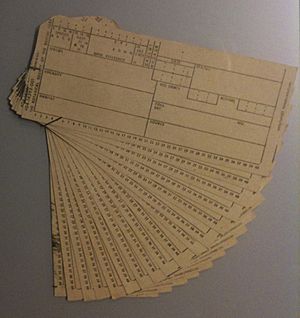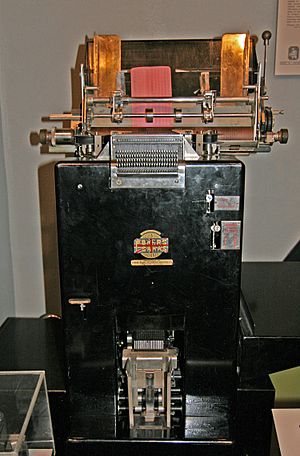Powers-Samas facts for kids

Powers-Samas was a British company that made special machines. These machines used punched cards to store and process information. They were a bit like early computers, but they worked mechanically.
Contents
The Story of Powers-Samas
The company started in 1915. An American company called Powers Tabulating Machine Company set up a branch in Europe. It was first named the Accounting and Tabulating Machine Company of Great Britain Limited.
A New Name and Purpose
In 1929, the company changed its name to Powers-Samas Accounting Machines Limited. The name "Samas" came from a French sales agency that worked with Powers. People sometimes called the company "Acc and Tab" for short.
Helping During World War II
During World War II, Powers-Samas played an important role. They built many Typex machines. These were secret coding machines, similar to the German Enigma machine. The British military and government used them to send secret messages.
Joining Forces: ICT
In 1959, Powers-Samas joined with another company called the British Tabulating Machine Company (BTM). Together, they formed a new, bigger company called International Computers and Tabulators (ICT). This merger helped create one of the largest computer companies outside of the United States.
How Powers-Samas Machines Worked
Powers-Samas machines were unique in how they read information. Unlike some other machines that used electricity, Powers-Samas machines worked mechanically.
Reading Punched Cards
Imagine a card with holes punched in it. These holes held information, like numbers or letters. Powers-Samas machines had small pins. When a pin found a hole, it would drop through. This movement would then trigger other parts of the machine. It was like a chain reaction that helped the machine do its job, such as adding numbers or printing reports.
Setting Up the Machines
To make a machine do a specific task, engineers had to set it up carefully. They used a special "connection box." This box had rods that lined up with the pins reading the cards. By arranging these rods in a certain way, they could tell the machine what to do with the information from the holes. It was a bit like programming the machine using physical connections instead of computer code.
Different Card Sizes
Powers-Samas used many different sizes of punched cards. Some had 21 columns, while others had as many as 130 columns. The most common card size was a 40-column card. It was quite small, measuring about 4.35 inches by 2 inches.


